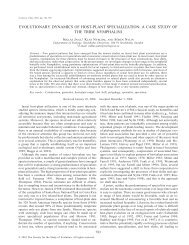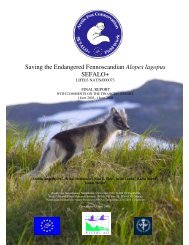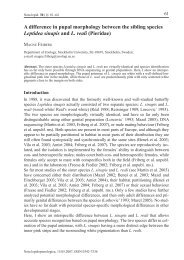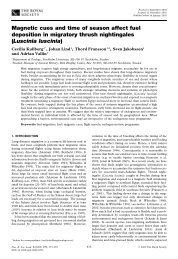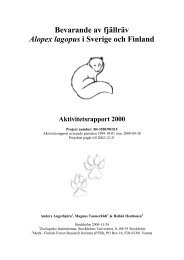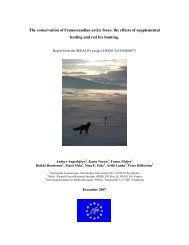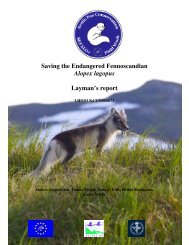Food-niche overlap between arctic and red foxes
Food-niche overlap between arctic and red foxes
Food-niche overlap between arctic and red foxes
Create successful ePaper yourself
Turn your PDF publications into a flip-book with our unique Google optimized e-Paper software.
Elmhagen et al. 1283sample was small in some years, the overall pattern indicatesthat <strong>arctic</strong> <strong>and</strong> <strong>red</strong> <strong>foxes</strong> would use similar prey bases similarly.Differences <strong>between</strong> the species at the same altitudeswere more likely due to temporal variations in prey availability,since they were never found at the same altitude inthe same year.<strong>Food</strong>-<strong>niche</strong> breadths varied substantially among years forboth species. Arctic <strong>foxes</strong> showed a higher degree of specializationthan <strong>red</strong> <strong>foxes</strong> when the lemming population wasin the increase <strong>and</strong> crash phases. During lemming low phases,both fox species were relatively generalistic. These variationsin food-<strong>niche</strong> breadth are probably consequences ofopportunistic feeding behaviours. When lemmings are abundant,both species use them to a large extent, but when lemmingdensities are low they find other prey. Since <strong>arctic</strong><strong>foxes</strong> were found at altitudes where lemmings should makeup a relatively larger proportion of the prey community, theyshowed more pronounced shifts <strong>between</strong> specialized <strong>and</strong>generalized feeding strategies.The opportunistic feeding behaviour of <strong>arctic</strong> <strong>foxes</strong> is welldocumented. Arctic <strong>foxes</strong> in coastal habitats have access tomore types of prey than inl<strong>and</strong> <strong>foxes</strong> do, <strong>and</strong> have a more diversifieddiet (Chesemore 1968; Fay <strong>and</strong> Stephenson 1989;Birks <strong>and</strong> Penford 1990; Hersteinsson <strong>and</strong> Macdonald 1996;Kapel 1999; Anthony et al. 2000). Foxes near bird coloniesincrease their consumption of birds <strong>and</strong> eggs upon the arrivalof migrating birds (Stickney 1991; Bantle <strong>and</strong> Alisauskas1998), while <strong>foxes</strong> in areas where prey are locally abundantadjust their use of habitat according to seasonal changes inprey distribution (Jepsen et al. 2002).Red <strong>foxes</strong> in southern Sweden have more diversified dietsthan those in northern Sweden (Englund 1965; Lindström1982). Red fox populations are also relatively stable in thesouth. No direct relationship has been demonstrated <strong>between</strong>reproduction <strong>and</strong> the availability of any particular prey species,<strong>and</strong> southern <strong>red</strong> fox populations are likely to be sociallyregulated. In contrast, the sizes of northern populations varymarkedly with the vole cycle (Englund 1970; Lindström 1989).Thus, just as <strong>arctic</strong> <strong>foxes</strong> in inl<strong>and</strong> <strong>and</strong> coastal habitats havedifferent feeding strategies, there appears to be a south–north gradient in the feeding strategies of <strong>red</strong> <strong>foxes</strong>. Alongthe gradient of decreasing productivity in Sweden, from northernforests to low-production mountain tundra, <strong>red</strong> <strong>foxes</strong>should have progressively less varied diets. This is supportedby Englund’s (1965) finding that <strong>red</strong> <strong>foxes</strong> on the mountaintundra consumed fewer birds than those in the forest.Because of their larger body size, <strong>red</strong> <strong>foxes</strong> require higherprey densities to sustain themselves than <strong>arctic</strong> <strong>foxes</strong> do(Hersteinsson <strong>and</strong> Macdonald 1992), <strong>and</strong> <strong>red</strong> <strong>foxes</strong> are usuallyfound in dens at lower altitudes, i.e., in more productiveareas. However, if <strong>arctic</strong> <strong>and</strong> <strong>red</strong> <strong>foxes</strong> are equally opportunistic<strong>and</strong> there are no differences <strong>between</strong> their virtual food<strong>niche</strong>s, it is difficult to see why <strong>arctic</strong> <strong>foxes</strong> would notendeavour to use the lower parts of their former range. Further,avoidance of lower altitudes, which has also been indicatedby radio-tracking of <strong>arctic</strong> <strong>foxes</strong> in Fennosc<strong>and</strong>ia (L<strong>and</strong>a etal. 1998), is the opposite of the behaviour of <strong>arctic</strong> <strong>foxes</strong> onSvalbard, where productive habitats are favou<strong>red</strong> <strong>and</strong> morebarren areas avoided (Jepsen et al. 2002). Instead, competitionwith <strong>red</strong> <strong>foxes</strong> may explain why <strong>arctic</strong> <strong>foxes</strong> have retreatedto higher altitudes, <strong>and</strong> the high degree of food-<strong>niche</strong><strong>overlap</strong> indicates that <strong>arctic</strong> <strong>and</strong> <strong>red</strong> <strong>foxes</strong> should competefor the same areas, as suggested by Hersteinsson <strong>and</strong> Macdonald(1982, 1992).What competitive mechanisms, then, may be important?Arctic <strong>and</strong> <strong>red</strong> <strong>foxes</strong> are territorial towards each other(Tannerfeldt et al. 2002) <strong>and</strong> it is unlikely that <strong>red</strong> <strong>foxes</strong> severely<strong>red</strong>uce prey densities in areas outside their territorialborders. Exploitative competition should therefore be of littleconsequence on a larger scale. Instead, observations inthe wild <strong>and</strong> experiments involving penned individuals haveshown that <strong>red</strong> <strong>foxes</strong> p<strong>red</strong>ominate over <strong>arctic</strong> <strong>foxes</strong> <strong>and</strong> cankill both adults <strong>and</strong> juveniles (Rudzinski et al. 1982; Schamel<strong>and</strong> Tracy 1986; Frafjord et al. 1989; Korhonen et al. 1997;Tannerfeldt et al. 2002). Arctic <strong>foxes</strong> also seem to avoid reproducingin dens near reproducing <strong>red</strong> <strong>foxes</strong>, which indicatesthat there is a competitive mechanism by which <strong>red</strong><strong>foxes</strong> can influence the distribution pattern of <strong>arctic</strong> <strong>foxes</strong>(Tannerfeldt et al. 2002). Interference competition, mediatedthrough territorial <strong>and</strong> encounter competition (Schoener 1983),could therefore be a mechanism of habitat segregation, with<strong>red</strong> <strong>foxes</strong> occupying the more productive habitats. The restrictedprey base in unproductive habitat will make <strong>arctic</strong><strong>foxes</strong> more dependent on lemmings than <strong>red</strong> <strong>foxes</strong> are.Therefore, competition <strong>between</strong> <strong>red</strong> <strong>and</strong> <strong>arctic</strong> <strong>foxes</strong> must beconside<strong>red</strong> in efforts to conserve the <strong>arctic</strong> fox population inFennosc<strong>and</strong>ia (Löfgren <strong>and</strong> Angerbjörn 1998).We conclude that <strong>arctic</strong> <strong>and</strong> <strong>red</strong> <strong>foxes</strong> on the Swedishmountain tundra have similar virtual food <strong>niche</strong>s. Observeddifferences in <strong>arctic</strong> <strong>and</strong> <strong>red</strong> fox diets appear to be consequencesof spatial segregation that may, in turn, be causedby interference competition. The <strong>red</strong> fox is the strongercompetitor <strong>and</strong> might exclude the <strong>arctic</strong> fox from more productiveareas. Thus, an expansion of the range of the <strong>red</strong> foxduring the 20th century might have led to a <strong>red</strong>uction in theactual <strong>niche</strong> of the <strong>arctic</strong> fox.AcknowledgementsWe are grateful for funding from Oscar <strong>and</strong> Lili Lammsstiftelse, Carl Tryggers stiftelse, foundations at the RoyalSwedish Academy of Science, Magnus Bergvalls stiftelse,European Union LIFE-Nature, <strong>and</strong> World Wildlife Fund Sweden.Fjällräven AB, AB Dogman, Campbell’s, Milko, CloettaFazer, <strong>and</strong> Tågkompaniet supplied products that were usedin this project. We are also grateful for all the hard work putin by voluntary field workers.ReferencesAbrams, P. 1980. Some comments on measuring <strong>niche</strong> <strong>overlap</strong>.Ecology, 61: 44–49.Angerbjörn A., Tannerfeldt, M., <strong>and</strong> Erlinge, S. 1999. P<strong>red</strong>ator–prey relations: <strong>arctic</strong> <strong>foxes</strong> <strong>and</strong> lemmings. J. Anim. Ecol. 68:34–49.Angerbjörn, A., Tannerfeldt, M., <strong>and</strong> Lundberg, H. 2001. Geographical<strong>and</strong> temporal patterns of lemming population dynamicsin Fennosc<strong>and</strong>ia. Ecography, 24: 298–308.Anthony, R.M., Barten, N.L., <strong>and</strong> Seiser, P.E. 2000. <strong>Food</strong>s of <strong>arctic</strong><strong>foxes</strong> (Alopex lagopus) during winter <strong>and</strong> spring in western Alaska.J. Mammal. 81: 820–828.Bantle, J.L., <strong>and</strong> Alisauskas, R.T. 1998. Spatial <strong>and</strong> temporal patternsin <strong>arctic</strong> fox diets at a large goose colony. Arctic, 51: 231–236.© 2002 NRC Canada



